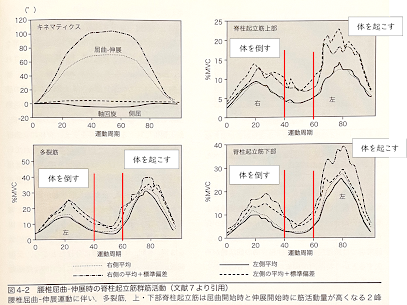November 11, 2022

The erector spinae muscles are a set of key muscles in the back responsible for supporting the body. Let's look at how they function when leaning down to perform a Japanese bow.
When you bend your upper body forward from a standing position, the erector spinae muscles work like a brake to prevent your torso from collapsing forward too rapidly.
Once you reach the bowed position, activity in the erector spinae temporarily decreases.
Then, as you return your body to an upright position, the erector spinae activate again, increasing their level of activity.
It has been reported that in low back pain patients, muscle activity persists even in the fully bowed position.
A characteristic of low back pain patients is their inability to efficiently engage and disengage their muscles. When pain is present, continuous tension is maintained in the muscles, leading to the phenomenon where the muscles stay tensed even when the body is bent forward.
In addition, the decrease in muscle activity during a bowing posture in healthy individuals occurs because body weight is supported by the intervertebral discs, joint capsules, and ligaments.Even during normal movement, the intervertebral discs are constantly subjected to strain.
In the case of degenerated discs, their ability to manage and distribute this load is compromised. As a result, excessive stress is applied to the joints and ligaments beyond what they are normally designed to handle, eventually leading to their failure and damage.
Because disc degeneration disrupts the spine’s ability to distribute load properly, repairing degenerated intervertebral discs becomes extremely important in maintaining spinal health.
ILC International Lumbago Clinic Tokyo



